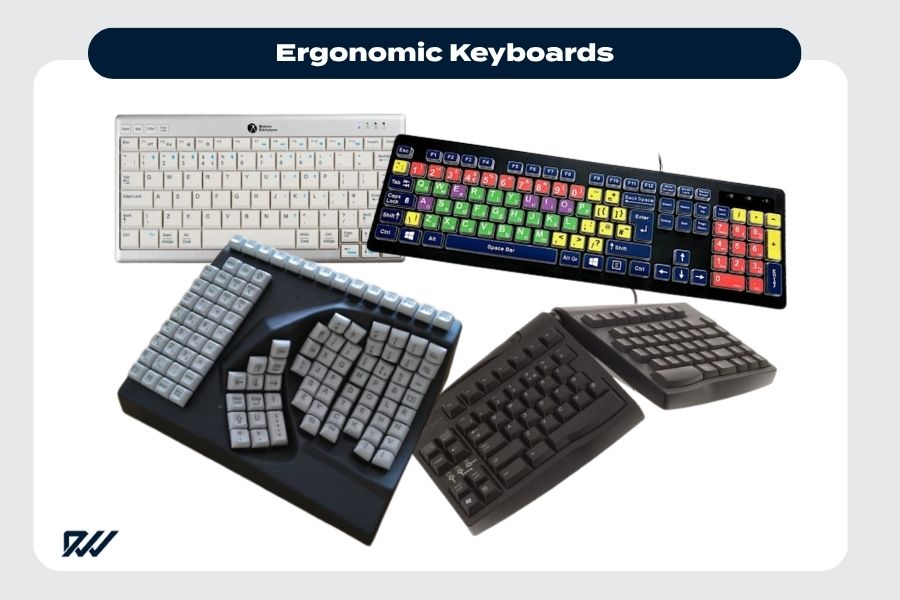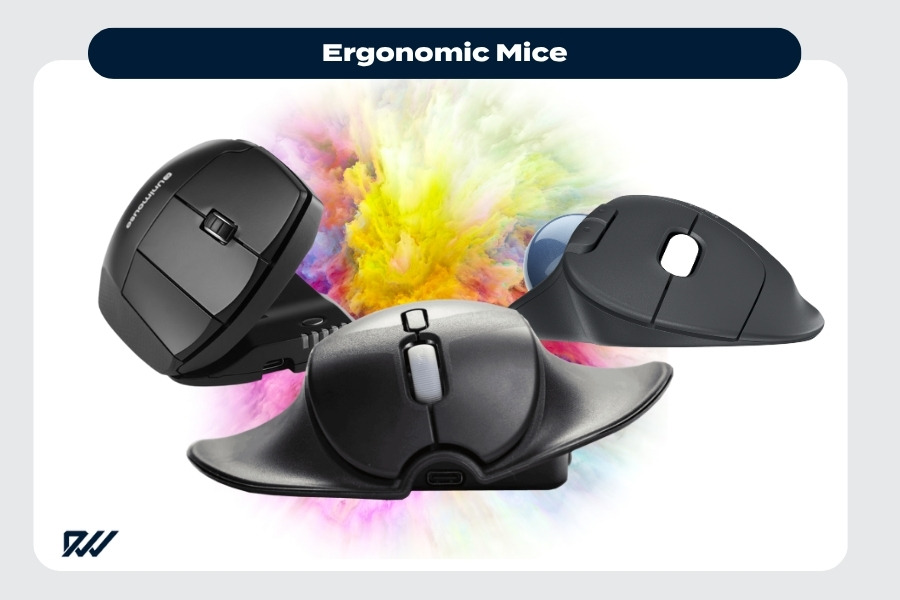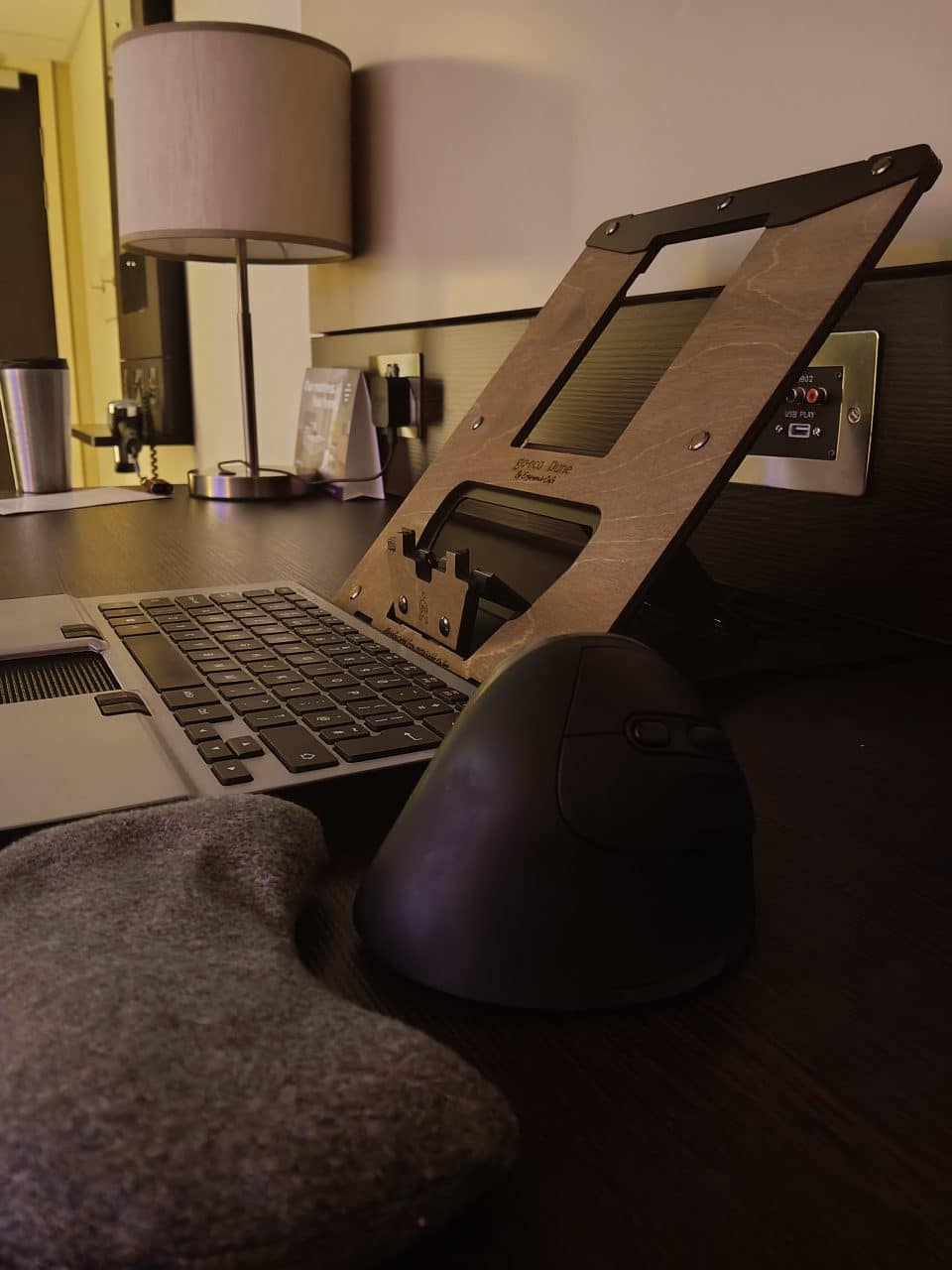Introduction
Creating a comfortable workspace isn’t just a luxury—it’s a necessity. With remote work, hybrid roles, and extended screen time becoming the norm in the UK, proper ergonomic keyboard and mouse set up are essential for long-term comfort and injury prevention. Whether you’re in a bustling corporate office or nestled in a quiet corner of your home office, integrating ergonomics into your setup can dramatically improve your well-being and productivity.
Injuries like repetitive strain injury (RSI) and carpal tunnel syndrome are no longer limited to factory lines. Today, they affect knowledge workers, students, and even gamers. Fortunately, with the right ergonomic approach to your keyboard and mouse, these issues can often be avoided altogether.

Are Ergonomic Keyboards and Mice Worth It?
The short answer? Absolutely.
Ergonomic peripherals are specifically designed to complement the natural posture of the human body. Unlike traditional models, they reduce the stress on your muscles and tendons. Here’s why they matter:
- Minimise mouse hand fatigue and typing strain
- Promote neutral wrist positioning and forearm alignment
- Decrease the risk of developing RSI and carpal tunnel
- Improve long-term comfort and typing efficiency
Over time, even slight discomfort can lead to chronic conditions if left unaddressed. Ergonomic tools act as proactive solutions for a healthier work life.
What Is an Ergonomic Keyboard?

An ergonomic keyboard is built to reduce unnatural wrist and hand positions by adapting to the body’s posture instead of forcing your body to adapt to a straight layout. Unlike conventional flat keyboards, ergonomic models:
- Feature split key layouts or tented designs
- Offer keyboard height adjustment and tilt angles
- Support a more neutral wrist position
- Are compatible with adjustable keyboard trays
By encouraging a healthier wrist and arm alignment, these keyboards help alleviate muscle tension, reduce fatigue, and improve overall typing ergonomics. Whether you’re typing for long hours in a busy office or working from your cosy home office, an ergonomic keyboard promotes better posture and plays a key role in injury prevention—especially for those prone to repetitive strain injuries like carpal tunnel syndrome.
Types of Ergonomic Keyboards
Let’s take a closer look at the most popular ergonomic keyboard designs and how each one supports comfort, posture, and proper keyboard usage throughout your workday.
Split Keyboards
Among the most recognised ergonomic designs, split keyboards are crafted to match the natural positioning of your arms and shoulders. Instead of forcing your hands inward toward a narrow layout, these keyboards separate the key clusters to allow for a more open, relaxed posture—reducing strain and tension across the upper body.
- Separate key clusters for the left and right hands to align with natural shoulder width
- Helps reduce ulnar deviation, minimising strain on the wrists and forearms
- Encourages healthy typing habits by promoting a more relaxed and balanced hand posture
This setup makes it easier to maintain proper keyboard posture, especially during long work sessions, and can significantly lower the risk of developing repetitive strain injuries.
Tented Ergonomic Keyboards
For those looking to enhance their typing posture without drastically altering their workspace, a tented ergonomic keyboard can offer a practical solution. These designs focus on refining wrist alignment and optimising desk space—perfect for both home and corporate office setups.
- Elevate the centre of the keyboard to create a more natural typing angle
- Mimic the natural resting position of the hands and forearms
- Ideal for reducing wrist twist and promoting a neutral wrist alignment
Compact Ergonomic Keyboards
Compact keyboard layouts take a minimalist approach by reducing the keyboard’s footprint. By removing non-essential sections like the number pad, these keyboards make room for better mouse placement and more efficient desk ergonomics.
- Remove the number pad to create a more compact and minimalist layout
- Allow the mouse to sit closer to the body, improving mouse and keyboard spacing and reducing shoulder strain
Together, tented and compact keyboards offer subtle but impactful ergonomic benefits—encouraging more natural hand positions, reducing fatigue, and making your workstation more comfortable and efficient.
Mechanical vs Membrane Ergonomics
When choosing an ergonomic keyboard, the type of key mechanism plays a significant role in both comfort and performance. Two of the most common types—mechanical and membrane—offer distinct tactile experiences and ergonomic benefits depending on your work style and environment.
- Mechanical: Offers tactile feedback and faster key travel, ideal for precision typing and improved responsiveness
- Membrane: Provides a quieter, softer keystroke experience, making it suitable for shared or noise-sensitive environments
While mechanical keyboards tend to be favoured by typists and professionals who value speed and accuracy, membrane keyboards may appeal more to users prioritising noise control and a softer touch. Ultimately, the best choice comes down to personal preference and how the keyboard fits within your ergonomic setup.
Advantages and Disadvantages of Ergonomic Keyboards
Ergonomic keyboards come in various shapes and designs, each engineered to meet different comfort, space, and performance needs. From split layouts to mechanical key switches, it’s important to weigh the strengths and limitations of each style before making your choice. The table below outlines the core pros and cons of the most commonly used ergonomic keyboards:
| Type | Advantages | Disadvantages |
| Split | Promotes natural arm posture | Takes time to adapt |
| Tented | Reduces wrist strain | Slight learning curve |
| Compact | Saves desk space | Limits functionality |
| Mechanical | Durable, precise feedback | Louder, higher cost |
| Membrane | Affordable, silent | Lacks tactile feel |
Each option offers valuable ergonomic benefits, but your ideal keyboard will depend on your typing habits, workspace layout, and sensitivity to sound or key feel. Investing in the right model can significantly enhance both comfort and efficiency over the long term.
What Is an Ergonomic Mouse?

An ergonomic mouse is designed to keep your wrist in a relaxed position, limiting stress on tendons and forearms. From vertical shapes to trackballs, these mice cater to various comfort levels and hand positioning styles.
Types of Ergonomic Mice
Vertical Mouse
The vertical mouse is a standout in the world of ergonomic design, crafted specifically to address wrist and forearm strain. Unlike traditional mice, it encourages a handshake-like grip that keeps the wrist in a more natural, upright position—reducing pressure and tension from prolonged use.
- Keeps the wrist in an upright, handshake-like position to reduce muscle tension
- Excellent for minimising wrist extension, helping to prevent long-term strain and discomfort
This design is particularly beneficial for users who experience discomfort with standard mice or are recovering from repetitive strain injuries. With a short adjustment period, a vertical mouse can offer noticeable improvements in both comfort and hand health.
Trackball Mouse
For users seeking precision without constant arm movement, a trackball mouse offers a unique ergonomic advantage. Instead of moving the entire mouse across your desk, you control the cursor by rotating a ball with your fingers or thumb—minimising repetitive motion and conserving space.
- Allows you to move the cursor using your thumb or fingers, rather than your whole arm
- Requires minimal arm movement, reducing shoulder fatigue and enhancing overall mousing ergonomics
Trackball mice are especially useful in compact workstations or for individuals with limited range of motion. With a bit of practice, they can provide a high level of accuracy and comfort, making them a solid option for long-term use.
Pen-style Mouse
Designed to replicate the feel of holding a pen, the pen-style mouse offers a sleek and intuitive alternative to traditional mouse designs. Its upright grip promotes a natural wrist posture while enabling precise control, especially in tasks requiring detailed hand movements.
- Mimics the natural grip of holding a pen, offering intuitive control and precision
- Ideal for creative professionals who require fine motor accuracy for tasks like graphic design or digital illustration
Though it may take a bit of time to adjust, the pen-style mouse is a favourite among digital artists and designers for its fluid control and ergonomic feel—making it a great tool for both productivity and comfort.
Left-handed Ergonomic Mouse
While many ergonomic devices cater to right-handed users by default, left-handed individuals now have tailored options that offer the same comfort and support. A left-handed ergonomic mouse is specifically designed to accommodate the natural grip and movement patterns of the left hand.
- Tailored specifically to fit the natural hand orientation of left-handed users
- Mirrors the ergonomic benefits of a standard vertical mouse, promoting comfort and usability without compromise
These mice are a crucial addition to inclusive office ergonomics best practices, allowing left-handed users to work comfortably without adapting to awkward or inefficient setups. They help ensure that productivity and posture aren’t sacrificed for handedness.
Trackpad
Although a trackpad is not technically a mouse, it can still play a valuable role in an ergonomic setup—especially for users who prefer minimal hand movement and an integrated, space-saving solution. Commonly found on laptops or available as standalone devices, trackpads respond to finger gestures, offering an alternative way to control the cursor without the need for gripping or clicking traditional buttons.
-
Requires minimal wrist and hand movement, reducing strain during prolonged use
-
Supports multi-finger gestures, enabling efficient navigation and control without excess motion
Trackpads are especially useful for users with limited desk space or those looking to avoid the repetitive clicking and dragging associated with traditional mice. When paired with proper wrist support and posture, they can offer a surprisingly ergonomic alternative—particularly for users who experience discomfort from gripping a standard mouse.
Advantages and Disadvantages of Ergonomic Mice
Choosing the right ergonomic mouse depends on your specific needs, daily tasks, and hand preferences. While each type offers unique benefits—from reducing strain to enhancing precision—there are also a few trade-offs to consider. Here’s a quick comparison of the most common ergonomic mouse types:
| Type | Advantages | Disadvantages |
| Vertical | Minimises wrist rotation | May feel unnatural at first |
| Trackball | No desk movement needed | Steeper learning curve |
| Pen-style | Precise and portable | Can be pricey |
| Left-handed | Inclusive and specialised | Less widely available |
Understanding these pros and cons can help you make a more informed decision based on your work habits, comfort needs, and long-term goals. Keep in mind, any ergonomic device should feel intuitive after a short adaptation period—and the benefits far outweigh the initial adjustment.
Best Ergonomic Set Up for Keyboard and Mouse
Ergonomic Keyboard Set Up
Achieving a comfortable and health-conscious keyboard arrangement is one of the most effective ways to improve daily posture, maintain correct desk posture, and prevent repetitive stress injuries. A proper ergonomic keyboard set up supports your natural wrist alignment, encourages better typing habits, and enhances overall efficiency—whether you’re working at home or in a corporate environment.
To optimise your ergonomic keyboard set up, follow these tips:
- As part of your desk setup, position the keyboard at elbow height to maintain proper desk height and posture.
- Use a wrist support for typing to reduce pressure on tendons and maintain alignment
- Keep wrists in a neutral, straight position to avoid strain during extended typing sessions
- Apply a slight negative keyboard tilt angle to encourage a more natural hand posture
- Consider installing an adjustable keyboard tray for flexible positioning and improved workstation ergonomics
- Work under consistent, glare-free home office lighting so you’re not leaning toward the screen or squinting at the keys.
By adopting these simple adjustments, you can dramatically reduce wrist tension and enhance comfort—creating a workstation setup that supports both short-term productivity and long-term well-being.
Hint: Your forearms should be parallel to the floor, and your shoulders should remain relaxed during typing.
Ergonomic Mouse Set Up
Your mouse plays a crucial role in daily computing comfort, and its placement and usage can greatly impact your posture and muscular health. A well-structured ergonomic mouse set up reduces arm fatigue, prevents strain, and allows for smoother, more controlled movement throughout the workday.
A proper ergonomic mouse set up includes:
- Keep the mouse aligned with the edge of your keyboard to maintain a natural reach and reduce shoulder strain
- Use a mouse pad with wrist support to cushion the wrist and promote a neutral hand position
- Ensure your elbow stays bent at a 90-degree angle for optimal posture correction at desk
- Select appropriate DPI settings for ergonomics to minimise excessive hand movements while maintaining pointer precision
- Maintain consistent forearm support when mousing to reduce fatigue and prevent pressure build-up in the wrist and shoulder
By fine-tuning these elements, you’ll support healthier movement patterns, minimise mouse hand fatigue, and create a workspace designed for both comfort and performance.
Pro Tip: Alternate between your left and right hand occasionally to reduce strain and build ambidextrous strength.
How to Use an Ergonomic Mouse and Keyboard
Even the most advanced ergonomic peripherals won’t deliver their full benefits if they’re not used correctly. To truly maximise the comfort and health advantages of your ergonomic gear, it’s important to pair the right equipment with mindful habits and proper technique:
- Avoid wrist extension by keeping your wrists flat and aligned with your forearms during use
- Refrain from overreaching for the mouse—keep it within easy reach to maintain relaxed shoulder posture
- Type gently to reduce finger fatigue and avoid unnecessary strain—there’s no need to pound the keys
- Take regular micro-breaks every 30–45 minutes to stretch, reset your posture, and reduce the risk of RSI
- Maintain proper keyboard posture by sitting upright, keeping your back supported and both feet flat on the floor
Remember, your habits are just as important as your tools. Even the most ergonomically designed equipment can fall short if paired with poor posture or repetitive strain behaviours—it’s the combination of smart tools and smarter habits that leads to lasting comfort and productivity.
Where Should Your Mouse and Keyboard Be on Your Desk?
Proper positioning is at the heart of workstation ergonomics. Here’s how to align everything just right:
- Position the keyboard directly in front of your torso to encourage symmetrical hand and shoulder alignment
- Ensure you have the optimum chair set up so that your elbows are in-line with your desk and therefore you keyboard and mouse
- Keep the mouse beside the keyboard at the same level to minimise lateral arm movement
- Ensure both peripherals are within a relaxed, natural arm’s reach to support healthy typing and clicking habits
- Align your monitor directly above the keyboard to maintain a neutral neck position and prevent strain
- Maintain tight mouse and keyboard spacing to avoid overreaching and reduce the risk of shoulder extension injuries
When these elements are properly aligned, your entire workstation works with your body rather than against it. Small adjustments—like bringing your mouse closer or lowering your keyboard—can have a major impact on reducing physical stress over time.
Consistent alignment not only improves comfort but also supports productivity by allowing you to move effortlessly between tasks without compromising posture or developing strain-related injuries.
Ergonomic Mouse and Keyboard Cost
Ergonomic Mouse Cost
Investing in a high-quality ergonomic mouse doesn’t have to break the bank. From simple vertical models to advanced, programmable designs, there’s an option for every budget and use case. Below is a breakdown of typical pricing tiers in the UK:
| Tier | Price Range | Examples |
| Basic | £15–£30 | Standard vertical mice |
| Mid-range | £30–£70 | Trackballs, multi-button vertical |
| Premium | £70–£150+ | Adjustable DPI, wireless, left-handed versions |
Whether you’re starting out or upgrading your workstation, selecting a mouse that aligns with your hand posture and workflow can significantly reduce fatigue and boost precision over time.
Ergonomic Keyboard Cost
The cost of ergonomic keyboards varies widely depending on features such as layout design, adjustability, and key mechanisms. Here’s a general guide to help you compare price points and features:
| Tier | Price Range | Examples |
| Basic | £20–£40 | Compact split layouts |
| Mid-range | £40–£90 | Adjustable tenting, mechanical types |
| Premium | £100–£200+ | Fully programmable, wireless, split mechanical kits |
An ergonomic keyboard is a long-term investment in your health and productivity. Choosing the right model for your needs can minimise strain and support better typing ergonomics throughout the day.
Combined Cost
If you’re setting up or revamping your entire workstation, bundling both an ergonomic mouse and keyboard offers the best of both worlds. Here’s what to expect when considering a complete ergonomic input solution:
| Tier | Price Range | Suitability |
| Entry Level | £35–£70 | Beginners and light home office use |
| Mid Range | £80–£150 | Full-time remote workers |
| Premium | £180–£350+ | Power users, chronic pain prevention |
Combining both ergonomic tools not only supports overall comfort but also ensures a balanced and efficient layout—making it easier to maintain proper posture and prevent repetitive strain injuries in the long run.
Conclusion
A thoughtful ergonomic keyboard set up & ergonomic mouse set up isn’t just about luxury—it’s about wellness. Whether you’re battling wrist discomfort or simply want to future-proof your working life, the right setup goes a long way. Prioritising proper seating posture, optimal desk height, and healthy typing habits transforms your productivity and comfort.
From split keyboards to vertical mice, UK users now have more choices than ever before to improve office ergonomics—at home or in the workplace. Small changes today can lead to long-term health and efficiency gains tomorrow.
FAQs
Can ergonomic keyboards prevent carpal tunnel syndrome?
Yes, they encourage a neutral wrist position and reduce pressure on nerves, helping prevent carpal tunnel over time.
Do I need a mouse pad with wrist support?
If you suffer from wrist fatigue or use your mouse extensively, wrist support can offer noticeable comfort and prevent strain.
Is a split keyboard better than a traditional one?
For many users, especially those who type for hours, a split keyboard allows for better posture and less ulnar deviation.
What’s the best mouse for reducing hand fatigue?
Vertical mice are the top choice as they keep your wrist in a natural, handshake-like position, reducing muscle tension.
How do I measure for the correct keyboard height?
Sit with elbows at a 90-degree angle. Your keyboard should align with your elbows, and your wrists should remain straight.
Are vertical mice better for gaming or work?
They’re better suited for work due to ergonomics, though some ergonomic gaming mice do offer vertical designs with high DPI settings.
